Audio-Technica Celebrates 60 With the Explosive Sounding AT-MC2022
unparalleled transparency, speed and true detail
It’s no secret that the world’s two largest cartridge manufacturers, Audio-Technica and Ortofon generate most of their cartridge income from inexpensive, mass-produced units, many of which they supply OEM to turntable manufacturers. Yet both lavish time, attention, and financial resources on the far smaller (it would be fair to say “tiny”) top of the market, where ultra-precision hand-built limited-edition models garner more attention than sales from audio enthusiasts. So why do that? Partly for the prestige, partly for the “trickle down” tech benefits and partly probably just to push the envelope and see far it can go and to where it leads.
Back in 2016 Audio-Technica released the ART 1000 cartridge, designed by the then retired Mitsuo Miyata along with his young successor then Product Development manager Yosuke Koizumi. Miyata’s dream, (some thirty years earlier!) had been to produce a cartridge with coils mounted directly atop the stylus, so stylus movement would directly translate to signal generation, the benefits of which should be obvious to all reading this. The downside is added mass directly atop the stylus and an open architecture that made the coils vulnerable to damage. But CDs got in the way before Miyata could realize his dream, so he turned his attention to designing headphones.
 Giant sized ART-1000 at CES. Note coils bonded to top of cantilever
Giant sized ART-1000 at CES. Note coils bonded to top of cantilever
When Audio-Technica put into production the AT ART-1000 I flew to Tokyo to both watch it being built and to better get to know the company. It was an eye and ear opening trip. The ART-1000 is still available from some sellers for $4,999.
While there I met young Yosuke Koizuma, now listed as "Audio Technica cartridge engineer" who honored me by bringing to the factory his super 45rpm record collection. Don't skip this video!
Hideo Matsushita founded Audio-Technica in 1962. At the time he had a tenured position curating an art museum. His long-term high-quality audio passion bit, he quit to start Audio-Technica, and soon thereafter released the AT-1 cartridge. The new MC2022 celebrates the company’s 60th anniversary. Today, the founder’s son Kazuo is Audio-Technica’s president.
Like the other large scale cartridge manufacturer, Audio-Technica’s line features orderly steps upward in sonic and technical quality. As Ken Redmond pointed out in his excellent ART20 review , to create the ART20, Audio-Technica took its $1500 AT-ART 9XI and replaced its aluminum/plastic body with an aluminum/titanium body and increased the magnet system’s yoke mass. The price increased as well, from $1500 to $2900.
The new AT MC2022 costs $9000. Its electrical specs are identical to the ART 20’s indicating that the “motor” is probably identical or very similar. The static and dynamic compliance specs differ but not appreciably. The big difference of course is the unified stylus-cantilever assembly, formed from a single, lab-grown diamond using chemical vapor deposition. This was previously accomplished by Sony in its XL-88D cartridge circa 1980, which I've been told was "carved" from a naturally occurring diamond and cost as much as Honda automobile (I've not been able to confirm that).
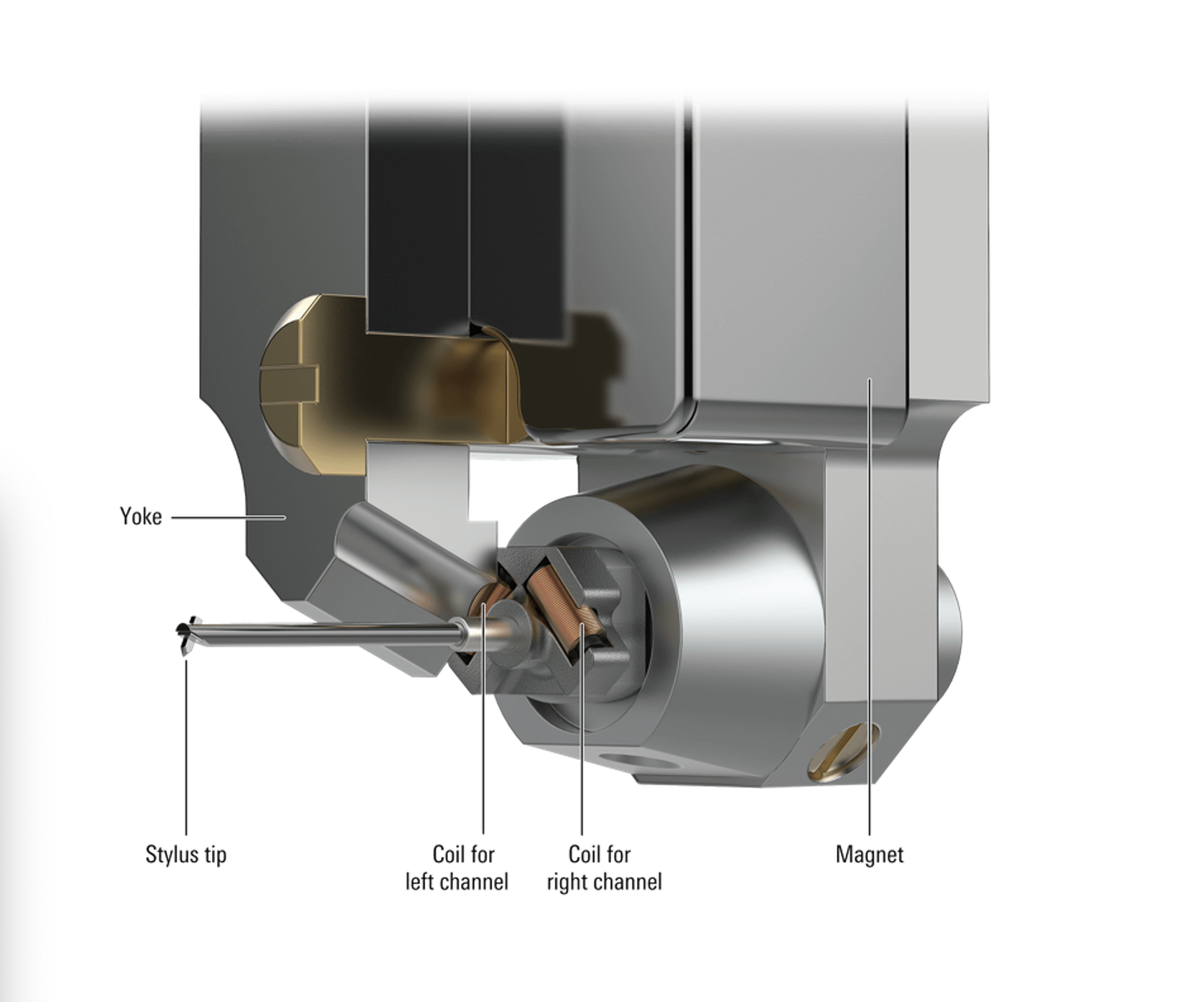 Audio Technica ART20 motor
Audio Technica ART20 motor
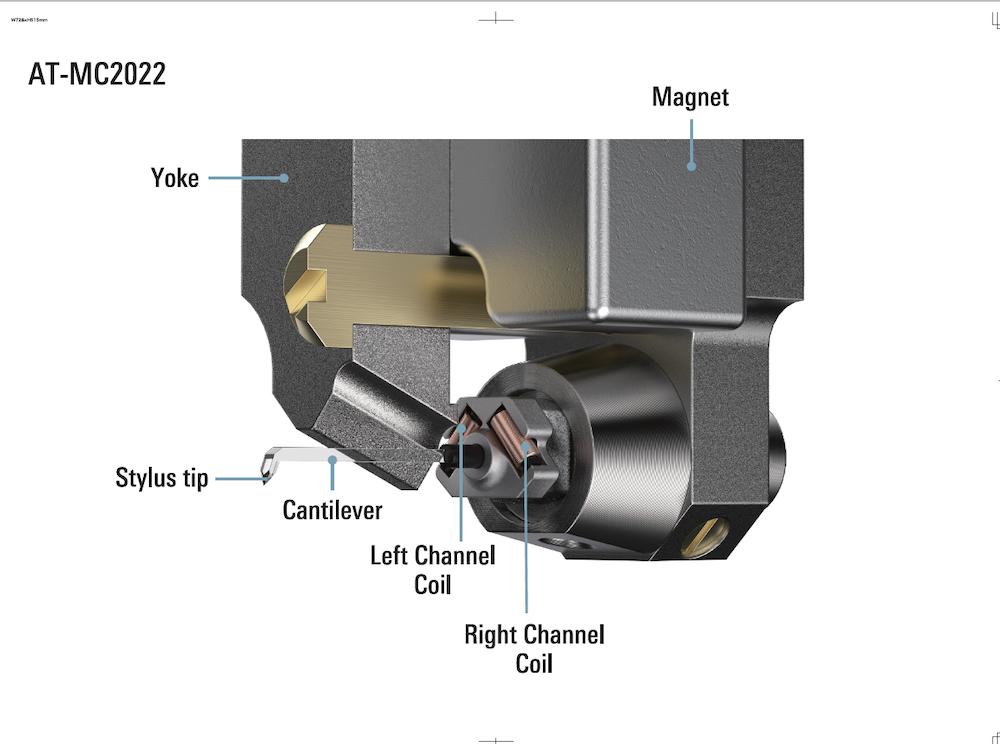
Only apparent difference is the unified cantilever/stylus assembly, but that's a big "only"!
The MC2022’s square cantilever is 0.22mm (0.0087”) wide, which is very slim. The dimensions of the line contact diamond stylus formed at the tip is 2.2 x 0.12 mil (or 56 x 3 µm) whereas the AT20’s is 1.5 x 0.28 mil (or 38 x 7 µm), which means the MC2022’s small radius is less than half that of the AT20 so it’s a true line contact that compared to the AT 20 should produce greater detail.
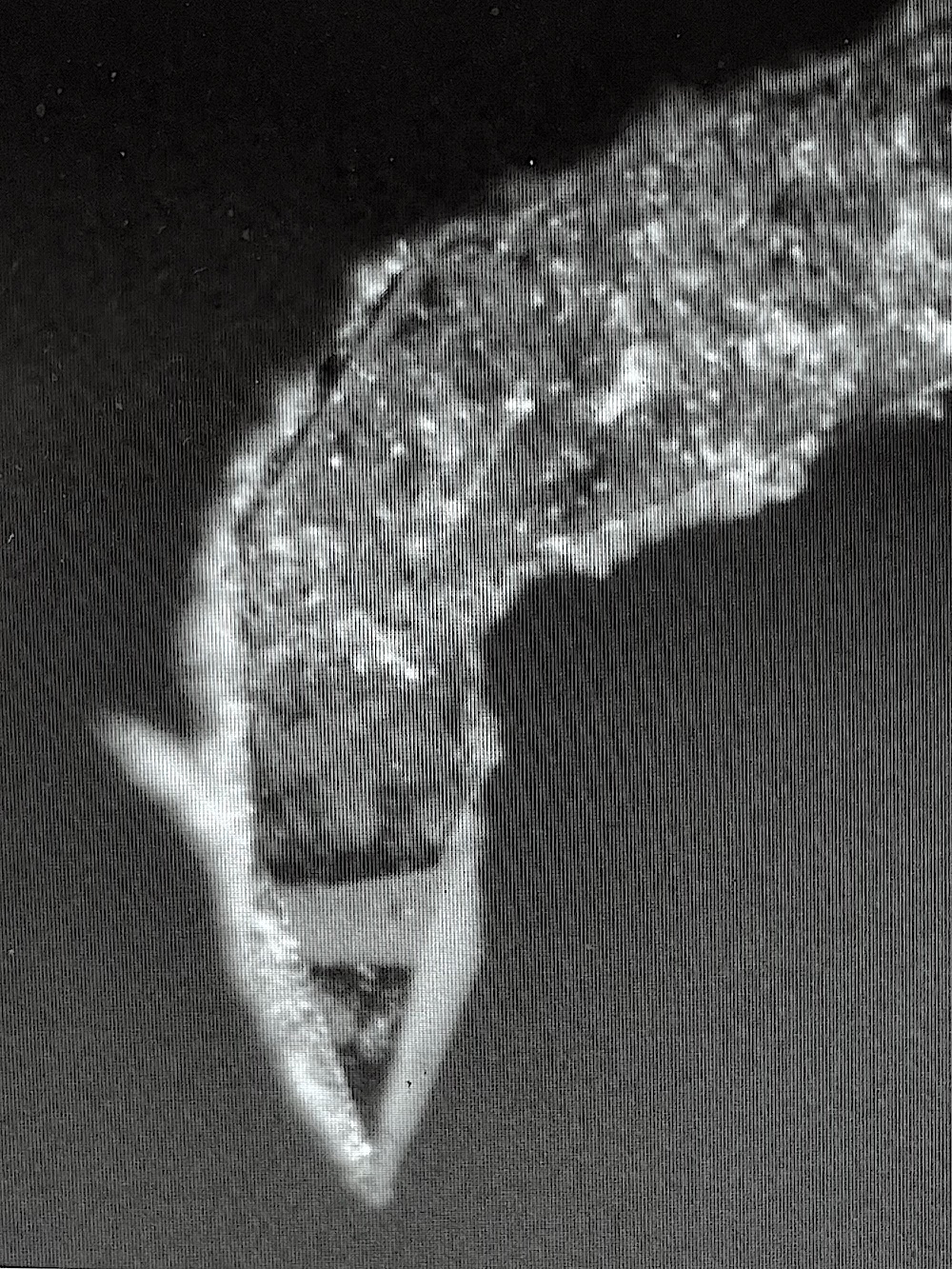 Review sample stylus, WallyScope photo
Review sample stylus, WallyScope photo
The body is also very similar to the ART 20’s (titanium and aluminum with an elastomer undercover), though with a greater gleaming gold “bling” factor enhanced with black cartridge body accents Audio-Technica says are inspired by traditional shippo enameling (Japanese cloisonné). It's presented in a deluxe wooden enclosure.
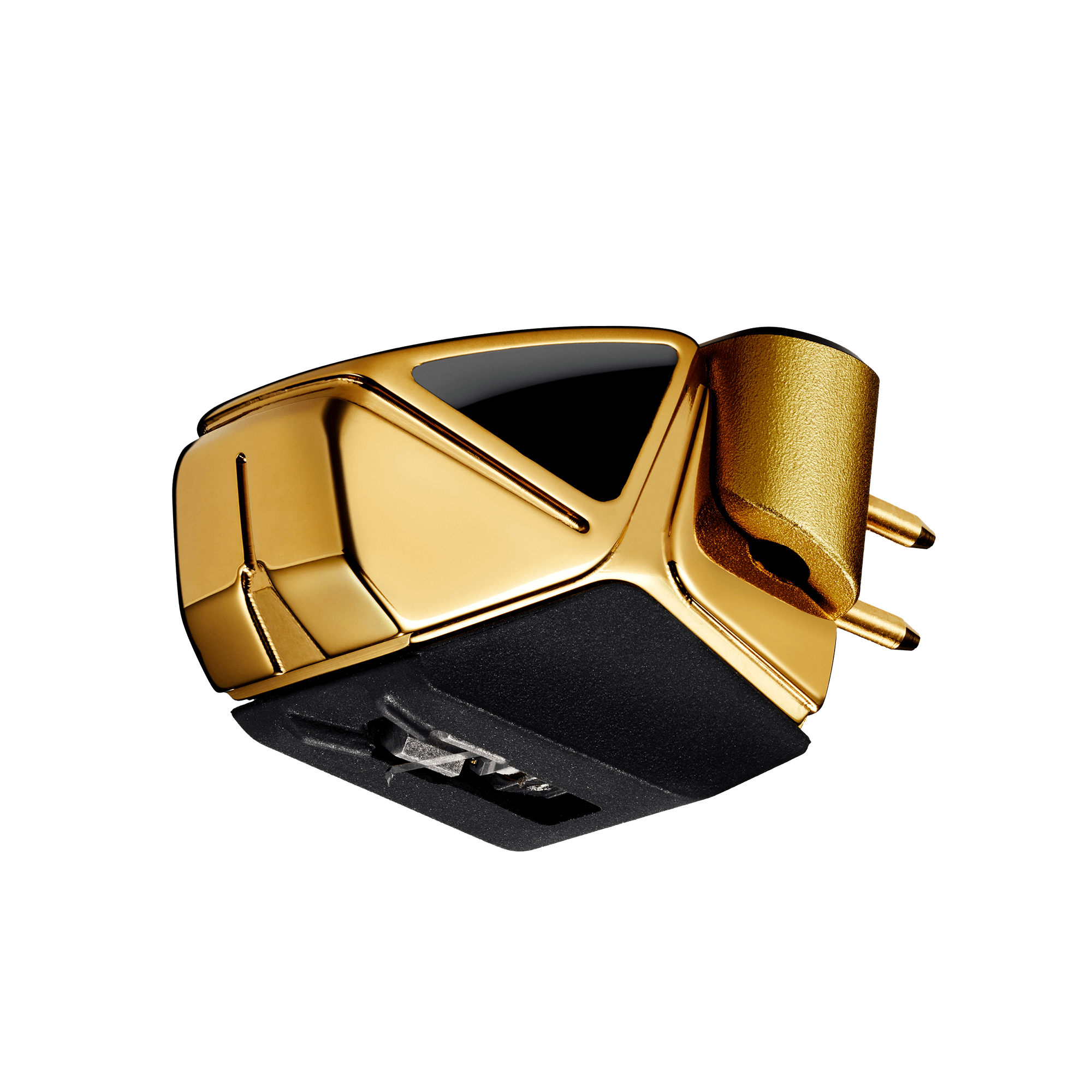 But the real keys to the MC2022’s sonic performance are the cantilever material itself and especially the lower tip mass produced by there being no stylus/cantilever joint requiring bonding or an insertion mechanism or mounting plate, and of course this design can’t be bested in terms of junction rigidity, because there isn’t one. However, as you can see in the microscope photo, the diamond makes a 90 degree turn well above the actual stylus, so that does add tip mass. Clearly the overall benefits of this design conceptually outweigh that one minor negative and though I can’t weigh it, I’d bet the tip mass here is still equal to or lower than on most if not all bonded and/or bonded and plate mounted styli.
But the real keys to the MC2022’s sonic performance are the cantilever material itself and especially the lower tip mass produced by there being no stylus/cantilever joint requiring bonding or an insertion mechanism or mounting plate, and of course this design can’t be bested in terms of junction rigidity, because there isn’t one. However, as you can see in the microscope photo, the diamond makes a 90 degree turn well above the actual stylus, so that does add tip mass. Clearly the overall benefits of this design conceptually outweigh that one minor negative and though I can’t weigh it, I’d bet the tip mass here is still equal to or lower than on most if not all bonded and/or bonded and plate mounted styli.
Anyone reading this who’s replaced the Ortofon 2M Red’s bonded stylus with the Blue’s far lower mass nude stylus and heard the startling difference that substitution produces in a $99 cartridge will need no convincing about the sonic improvement a one piece cantilever/stylus might produce in a state of the art design.
The first diamond cantilever cartridge I heard was the Transfiguration Proteus D from Immutable Music (when company founder and cartridge designer Seiji Yoshioka, passed away, his family chose to closer the business, rather than sell it). I’d been well acquainted with the boron cantilevered Proteus, which was plenty fast and “explosive” but I was unprepared for the major difference between it and the Proteus D. The “D” version sounded altogether like a different cartridge, though the only difference was the cantilever. The sound wasn’t “clinical” or “thin” but rather “fast” and "full bodied" with a feel of a direct path between stylus and electrical signal propagation. Not for those who like things “laid back”, or as Ken Redmond colorfully describes it: “mixing board” versus “audience” perspective.
Audio-Technica takes the diamond cantilever to the next level by laser cutting the stylus from the lab grown diamond’s tip. No glue, no fastening plate, nothing. Another benefit of this design is that unless the laser operation goes awry (not likely or even possible) there will be no stylus rake angle or zenith angle “off spec” errors. As J.R. Boisclair’s research points out, zenith angle error, even on costly cartridges using traditional construction methodologies can be as high as 10± degrees from line contact perpendicularity with the cantilever. Manufacturer accepted tolerances are as high as 5 degrees. The negative tracking and sonic consequences, while minimized by some out of ignorance and/or arrogance, are considerable as Mr. Boisclair demonstrates in the Florida Expo video recently published on the TrackingAngle YouTube channel.
Set Up
I first installed the cartridge on the OMA K3’s Schröder 12” arm, which has an effective length of 280mm. To set SRA I used the WallyScope (shown here during a DS Audio optical cartridge set up for an upcoming review). Predictably, SRA was close to 92 degrees with the arm set parallel to the record. Oscilloscope measurements duplicated A-T’s separation and channel balance specifications: 30dB@1kHz separation and .5dB channel balance. Often the actual separation measurements are higher than what the oscilloscope measures. The channel balance numbers are more critical. The .5 L-R/R-L indicates close to perfect azimuth setting as well.
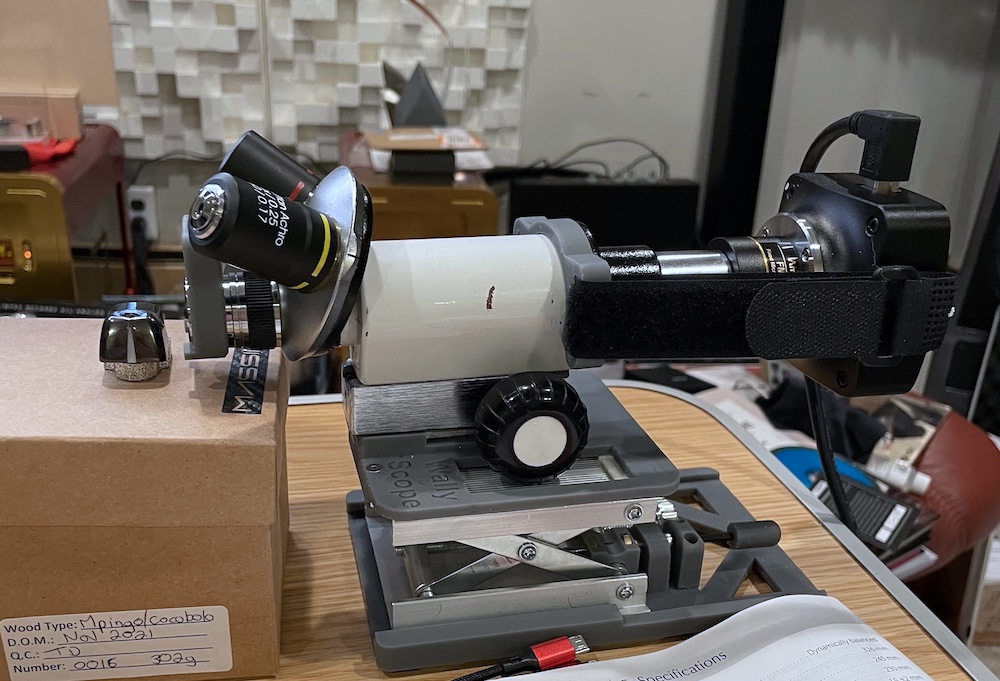
The biggest set up issue was caused by the stylus tip’s location tucked well behind the cartridge front and not so easy to see. The upside is it’s difficult to accidentally “bonk” and destroy.
While the generous .55mV output and relatively high 12 ohm coil impedance (compared to some of today’s super low output/ultra-low internal impedance cartridges) might make the MC2022 a less than ideal candidate for a transimpedance current-based phono preamplifier, I ran it into the CH Precision’s current-based input, setting the gain to +10dB as well as into its MM/MC voltage gain input using a Ypsilon MC-10L step up transformer that’s ideal for a .55mV output cartridge. The load seen by the cartridge is 500 ohms. Audio-Technica recommends greater than 100 ohms. I loaded down the secondary to get it to around 200 ohms but didn’t hear a significant difference. The results were equally good, though somewhat different sounding run either way. However, the differences aren't worth going into.
I set VTF at the recommended 1.8g and once the cartridge had some time on it, I used the Ortofon test record and found the MC2022 to be an outstanding tracking cartridge capable of negotiating cleanly all but the 100µm lateral peak band and even on that one it tracked with just a slight buzz on one channel that might have been fixable with a minor anti-skating tweak but it was so otherwise well dialed in I left it as is. Some MCs just slide off the record on that track—not that actual music is ever cut at that level.
Listening
Let’s start with the smallest picture before getting into the big picture and before getting into the audiophile checklist weeds. When you lower the stylus down on the record and hear that first "pop" impulse it can often write the entire review—or at least a large part of it. if it's a loud, long-lasting mid bass unfocused "blob" you can usually be sure the cartridge will have a warm mid bass signature that will be heard on every record you play. The best cartridges land on the record like the best Olympic divers hit the water: there's hardly a break in the water, almost no sound and the diver disappears. When the MC2022 lands on the record there's hardly a sound and what sound there is, is a 'pip' not a "POP". No sonic splash.
Not surprisingly then this cartridge, as only a very few in my experience have managed, sounds just about like it’s not there. In my world that’s the goal. I don’t want to hear any character, which is not the same as saying it “lacks soul” or is short of “musicality” or any other timbral, textural or transient quality that is an identifiably characteristic given a positive euphemistic spin.
Some cartridges are intended to impart a particular pleasing character and that’s fine too if that’s what you like or if such a quality complements your system’s sound and you're looking to take it there. Other cartridges have a “pinch” of something expertly applied —like the wooden bodied Analog Relax 1000 I reviewed a few years ago, and that’s fine too. That's a spectacular example of the cartridge building art and the additive quality so subtle it pretty much disappears, though you'd hear it's absence.
The original green-bodied Lyra Atlas definitely delivered unprecedented detail, at least in my experience, based upon considerable effort at eliminating resonances, but it also had a clinical, sharp edge. The Atlas Lambda restored lost textures without losing detail and the combined recipe produced a similar “not there” quality, though as a reviewer, communicating the improvement required writing about the textures being “added”. That major sonic change was mostly accomplished with a new damping elastomer.
The result there and here is that the less identifiable the cartridge’s character is, the more truer is the musical information that you experience, and the more of it there is to hear. Of course, there are ways to describe what listening to music with the MC2022 is like. So here goes.
The cartridge produces explosive, large-scale dynamics, and ultra-detailed micro-dynamics with precise in-between gradations—the kind that produces a “live” sensation on well-recorded music. That quality is immediately apparent, and was the first time I heard the cartridge live at an audio show. The MC2022 excels at detail resolution, three-dimensional imaging, image solidity, precise, fast attack, generous sustain and long-tailed decay into black. All the diamond cantilevered cartridges I’ve heard exude this quality to one degree or another along with transient precision minus an artificial "edge", and an overall effervescent, non-mechanical presentation that was also immediately obvious the first time I heard that Proteus D. The MC2022’s one-piece diamond cantilever-stylus elevates all of this to another level of speed while maintaining full-bodied delivery.
The music’s scale did not affect the cartridge’s dynamic performance. I’ve previously referenced the Mark Levinson 45rpm recording Elliot Fisk, Guitar (Mark Levinson, MAL 6). Fisk’s control over the musical dynamics is as precise as his finger work. The cartridge’s response to the recording’s low level dynamic ebb and flow was effortless as it reported minute level shifts that fully communicated the artist’s intentions. The delivery of delicate transient textures was equally effortless, helping to create the sensation of a performer playing in the room between the speakers—yes I know, you’ve read that before, and I’ve written it before so let’s just say this cartridge's responsiveness produced an even more intense sensation of that. The guitar’s body was also presented cleanly and free of the annoying detail robbing additive “warmth” lesser cartridges impart, yet the instrument’s body was clearly present. The result was a “tactile” experience of fingers on strings; midrange textural beauty without additive sludge. Precision without decapitated body and mostly an effortless, non-mechanical presentation. Of course, that Mark Levinson recording is also phenomenal.
To test the cartridge’s presentation at the other end of the dynamic trail, I played John Williams’ “Liberty Fanfare” from Winds of War and Peace first released in 1988 on Wilson Audiophile Recordings at 33 1/3 and more recently as a double 45 by Analogue Productions (APC-8823-45). The National Symphonic Winds consists of mostly winds plus some brass and percussion. There’s not a great deal of bass coming from this ensemble other than from the lone bassist and the giant bass drum “thwacked” by what conductor Lowell Graham describes as “The Mallet of Death”. When that “thwack” first hit, the room shook with as deep and as tight a “thwack” as I’ve ever heard from the recording, followed by a remarkably clean, long-lasting decay into silence. Residual groove noise was just about non-existent, even on the well-played original. The MC2022 is as quiet a tracker as I’ve heard and possibly the quietest (other than from optical cartridges that don’t “read” deflections caused by dirt or physical defects).
The follow up “thwacks” were equally impressive and not marred by additive mid-bass colorations some cartridges produce that soften the initial transient and muddy the sustain. The bottom end is all there and how. If there’s no bass on a record, you will not hear any. That might disappoint on some records with anemic bass (many rock records from the ‘60s and ‘70s) that might sound better played back using a cartridge with additive resonance produced “warmth”, but I’d rather have accuracy that translates as deeper, tighter, more appropriate bass minus additive “overhang” that also delivers textures and fast settling time. The MC2022 does all of that.
Resonant excesses removed almost always reveals greater midrange detail, particularly on male vocals and piano—but also on female vocals that then take on a freer, less "chesty" sound. It takes some getting used to. I used to enjoy the room shaking “bass” on the U.K. pressing of Small Faces’ Ogden’s Nut Gone Flake (there's none on the American original), particularly on “Lazy Sunday Afternoon” and on “Changes Circles Spinning” on Moby Grape’s overlooked minor gem Truly Fine Citzen. The bass that shook the room on certain notes on both records was clearly produced by a resonance that swamped everything else. It was fun—a lot of fun—but with the bottom better “tucked in”, satisfying details emerged on both records especially from the vocals just above the sonic "boom" (the MC2022 isn't the only cartridge to improve the sound of these records in that a regard, but it seemed to do it most effectively).
The MC2022 is also free from lower mid-range resonances, which helps deliver ideal reproduction of male vocals and piano. Last night I decided to play what I wanted rather than what a review called for and was I in for a surprise. I played the EMI Centennial edition of “Hunky Dory”. I’ve played that edition and others for more than fifty years! This was “Bowie in the room”. But not just him. The dynamic presentation of the piano on Biff Rose’s “Fill Your Heart” startled me. I was not just hearing a piano, I was hearing a person playing it, bearing down on the keys in places, laying off in others with a clarity of purpose I can't recall ever before hearing. All of these dynamic shifts, some subtle but many real “bangers”, were new. The clarity of the attack was also notable. The lead electric guitar on the V.U. inspired “Queen Bitch” has never sounded so coherent and "round". My mental notes on just this record could take up pages so I’ll stop.
Image size precision was another indication of this cartridge’s exceptional performance. I played just for fun an original pressing of Otis Redding Live In Europe (Volt S-416). There hasn’t yet been a good reissue. Despite being a less than ideal recording overall it has some amazing qualities including “you are there” transparency, though you are "there" seemingly in the balcony with a high quality portable recorder and the people sitting next to you are clapping really loudly!
But Otis, way down there sounds live as a tiny spec of high energy greatness. Until I heard Frank Sinatra sing “Try A Little Tenderness” I thought it had been written for Otis. It ends the show and as a live concert moment it’s one of the most exciting ever recorded. Otis goes crazy, the audience even more so. This cartridge’s pinpoint image of Otis was mind blowingly precise and with the proper distant perspective—and I’ve been playing this record since 1967—and his breathing and gesticulating never so well expressed. Last night was one of those “it’s two in the morning I’d better stop and go to sleep” nights.
I could go on for paragraphs about how Small Faces, Small Faces, Small Faces (IMSP 008) sounded —one of the greatest rock records ever as far as I’m concerned (I think engineered by Glyn Johns) and one with elements of American soul, r&b, hard rock, psychedelia, British "seaside", baroque-pop ala "Lady Jane", etc.— and how the sound so surprised me, but I'll keep it to a few and describe it so that even if you've never heard the record, you'll get what I'm talking about. The opener "(Tell Me) Have You Ever Seen Me" has about the most anemic bass line I've ever heard on a record. It might not even be a bass, but it usually swamps the sound and overlays everything else. This play it stayed in an assigned space and actually kept time. It doesn't normally do that. Ronnie Lane next sings "Something I Want to Tell You" with his lips just about touching the microphone. It's a totally dry recording. He's there in the room on the right channel. I've never heard it sounding so real. I almost felt like wiping off the speaker.
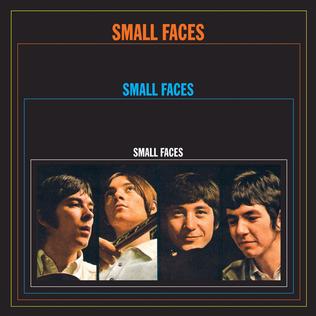
The next song "Feeling Lonely" has tambourine on the left channel but right there in the center hovering in space is some kind of temple bell as clear as a, well bell, that I've just not heard before at least not so clearly defined and round. Finally let me tell you about the raucous ending to the song “Tin Soldier” (not on the album but included on a well done Castle Records reissue of the album). It reminded me of how Otis’s version of “Try A Little Tenderness” ended and looking at the late 1967 recording date, and given Steve Marriott’s love of r&b it’s quite possible he was inspired by it (another hint is that Marriott produces his share of "gottas" on the album!).
Here's the final track on the album played incessantly since 1967!
One more example of this cartridge's timbral and transient "rightness". There's an album called The Video All-Stars play TV JAZZ THEMES (SF-8800) on Somerset Records. Yes, home of the 101 Strings The tunes, are, yes, TV themes like "77 Sunset Strip", "Peter Gunn" etc.. I saw this one in the $1 bargain bin and notices the "audio mix" credit went to Bill Putnam! So I grabbed it and then noticed the players: Paul Horn, Gus Bivona, Red Mitchell, Frank Rosolino, etc.—great studio cats. The sound on this record is early stereo insane but usually the frequency extremes are excessive: bass too heavy, top end era-searing. The AT MC2022 tames both ends a correctly delivers the middle.
Before retiring last evening, I played a few sides of the sonically and musically astonishing British Decca production of Porgy and Bess with Lorin Maazel and the Cleveland Orchestra & Chorus (Decca SET 609-11) recorded in 1975 with leads Willard White and Leona Mitchell. It’s among the best sounding recordings I own and not too costly on Discogs in either this or the same London edition OSA 13116). I always thought Kenneth Wilkinson engineered it and why not, it sounds good enough to have been, but there are no engineering credits so I don’t know who did, nor do I know why I thought he'd engineered it).
The vocals, whether male or female, solo or massed chorus as reproduced by this cartridge were as effortless, natural and realistic sounding as I’ve ever heard them and you can make a check list of what that means and I’d check off the whole list if you presented it to me. And they were precisely sized on the stage. Even though the vocals are bathed in reverb, the voices remain clarified, and three-dimensional on the stage. Any lingering thoughts about the low bass performance would be dispensed with at the end of side two’s single tympani thwack.
Last night was one of those evenings of listening pleasure, discovery and awe produced in great part by the truly remarkable Audio Technica AT-MC2022. The rest of the system didn’t hurt the experience but I’d grown accustomed to most of it. This was a special evening.
Conclusion
With the AT-MC2022, if you want “string sheen” it had better be on the record. If you want deep bass or midbass warmth from any instrument or voice it had better be on the record. The cartridge will not produce it. If the record has cleanly defined transients you'll hear them reproduced with exceptional, unforced clarity, free of artificial edge.
I own many wonderful cartridges and there’ll soon be a video showing most of them. The Audio-Technica AT-MC2022 is right there at the very top along with only a few others (though I’m sure there are others I’ve never heard): the Lyra Atlas Lambda SL, the Ortofon MC Diamond and the X-quisite ST. The X-quisite shares “one pieceness” with the AT-MC2022 in that it features a unique one-piece ceramic cantilever coil former. The diamond stylus is inserted and bonded. Both these cartridges produce exceptional transient precision, speed, and clarity. I’m certain you’d recognize these qualities without knowing what you were hearing, and you’d hear in them unique and desirable performance characteristics. The other two are also top performers for other reasons.
The AT-MC2022 cartridge delivers, in my experience, unprecedented transparency, timbral honesty, midband "palpability", transient speed and clarity and a “wide-openness” I’ve not heard elsewhere. You definitely pay a lot for a lot of “nothing” and "nothing" is what I want from a phono cartridge, because a phono cartridge that adds nothing gives you everything. You may have other ideas. It’s not a cartridge you’d buy to use to “tune” your system one way or the other. It won’t do that.
To get the most from the AT-MC2022 only the finest, most rigid tonearms and highest performing turntables should be used. The cartridge on the OMA K3 was spectacular as it was on an upcoming reviewed turntable fitted with the Kuzma Safir 9. It was not quite as good on the supplied arm with that ‘table but that’s another story. If you’ve got $9000 for a cartridge, you’ve most likely already got an arm and ‘table up to the job.
The AT-MC2022 is supposedly a limited-edition model. To quote Acoustic Sounds Chad Kassem about unique and limited record buying opportunities: "Buy now, or cry later".
Specifications
Cartridge & Stylus | |
|---|---|
Frequency Response | 20 to 50,000 Hz |
Channel Separation | 30 dB (1 kHz) |
Vertical Tracking Angle | 20° |
Vertical Tracking Force | 1.6 to 2.0 g (1.8 g standard) |
Stylus Construction | Unified line contact (integrated cantilever type) |
Recommended Load Impedance | ≥ 100 ohms (when head amplifier connected) |
|---|---|
Coil Impedance | 12 ohms (1 kHz) |
DC Resistance | 12 ohms |
Coil Inductance | 25 μH (1 kHz) |
Output Voltage | 0.55 mV (1 kHz, 5 cm/sec.) |
Output Channel Balance | 0.5 dB (1 kHz) |
Cantilever | 0.22 mm (0.0087") square diamond |
Static Compliance | 21 × 10-6 cm/dyne |
Dynamic Compliance | 15 × 10-6 cm/dyne (100 Hz) |
Cartridge Weight | 9.5 g (0.34 oz) |
Dimensions | 17.3 mm (0.68”) × 17.7 mm (0.70”) × 26.7 mm (1.1”) (H × W × D) |
Accessories Included | Non-magnetic screwdriver, Brush, Washer × 2 , Cartridge installation screws (M2.6) (5.0 mm (0.20”) × 2, 8.0 mm (0.31”) × 2, 10.0 mm (0.39”) × 2, 12.0 mm (0.47”) × 2), Protector, Case (wooden box), Accessory pouch |
Threaded Hole | M2.6 × 2 |
Stylus Curvature Radius | 2.2 × 0.12 mil |


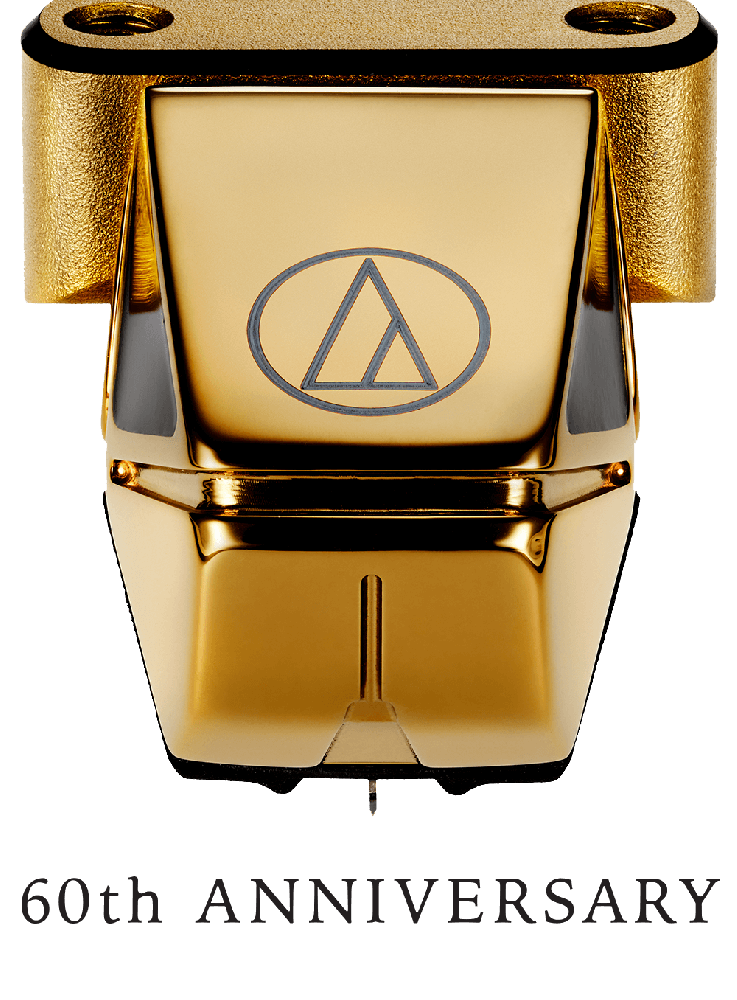







































.png)








